 Last additions - Moriyama 守山市 Last additions - Moriyama 守山市 |

San San MoriyamaApr 15, 2014
|
|

Moriyama City HallApr 15, 2014
|
|

Moriyama City HallApr 15, 2014
|
|

My video of the Katsube Shrine Fire Festival on Jan. 12, 2013. Three Japanese kids report in English.Jan 21, 2013
|
|

Moriyama manhole, Shiga Pref.Jan 17, 2013
|
|
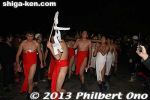
Jan 17, 2013
|
|
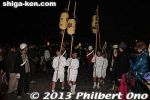
The lantern bearers lead the way as the taiko drum bearers exit the shrine.Jan 17, 2013
|
|
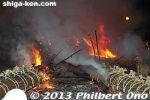
Jan 17, 2013
|
|

Jan 17, 2013
|
|
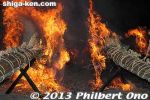
Jan 17, 2013
|
|
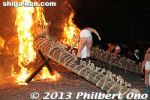
Jan 17, 2013
|
|
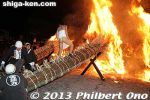
Jan 17, 2013
|
|

Jan 17, 2013
|
|
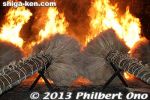
Jan 17, 2013
|
|
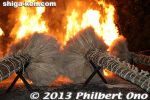
Jan 17, 2013
|
|
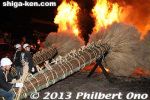
Jan 17, 2013
|
|
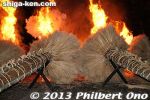
Rear view of burning torches.Jan 17, 2013
|
|

Jan 17, 2013
|
|
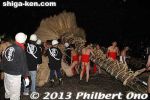
Jan 17, 2013
|
|
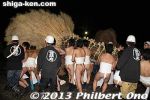
Jan 17, 2013
|
|
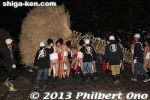
Jan 17, 2013
|
|
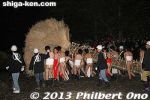
Jan 17, 2013
|
|
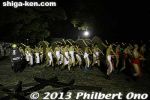
Jan 17, 2013
|
|

Jan 17, 2013
|
|
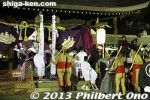
The men receive sacred sake and a good-luck charm from a shrine priest. The ceremony is called, Shushi-mairi (しゅうしまいり 牛玉参り).Jan 17, 2013
|
|
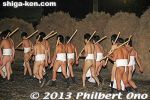
The older men wear red loincloths and the younger ones wear white.Jan 17, 2013
|
|
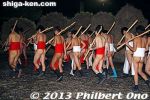
They all carry a shushi stick imprinted with "Prayer for family safety and health" (奉納勝部神社 家内安全 かない あんぜん).Jan 17, 2013
|
|
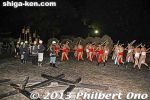
All the Torch and taiko drum bearers (たいまつぐみ 松明組) and helpers (せわかた 世話方) now line up in front of the shrine to receive sacred sake (おみき お神酒) and a good-luck charm (おふだ お札).Jan 17, 2013
|
|

In the foreground are torch stands, partially burnt.Jan 17, 2013
|
|
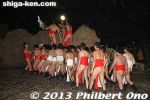
Jan 17, 2013
|
|
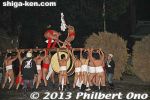
Jan 17, 2013
|
|
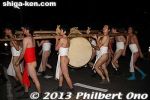
The taiko men parade around the neighborhood from about 6:15 pm to 7:50 pm. (たいこ わたり 太鼓渡り)Jan 17, 2013
|
|
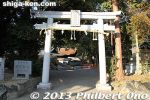
Another Katsube Shrine torii.Jan 17, 2013
|
|
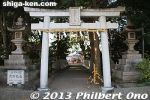
Katsube Shrine torii.Jan 17, 2013
|
|
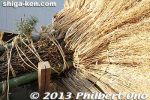
Jan 17, 2013
|
|
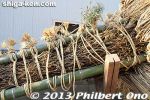
Jan 17, 2013
|
|
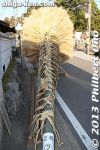
The torches are about 5 meters long and weigh over 400 kg.Jan 17, 2013
|
|

Jan 17, 2013
|
|
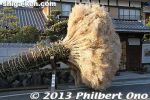
Jan 17, 2013
|
|

Jan 17, 2013
|
|

Some 400 bundles of rapeseed hulls are used for the 12 torch heads. The torch head smells like tatami mat.Jan 17, 2013
|
|
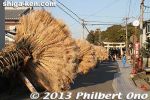
Jan 17, 2013
|
|

Jan 17, 2013
|
|
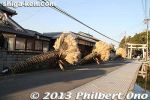
Jan 17, 2013
|
|
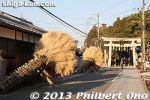
The torches are made of tree branches, bamboo, and straw from rapeseed hulls. Many people are involved in gathering the materials and making the torches.Jan 17, 2013
|
|
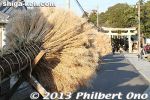
A total of 12 giant torches would be lit up for the festival. In the old days, they had more torches, but the number has decreased due to the difficulty of procuring materials.Jan 17, 2013
|
|
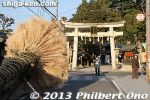
Six more torches were right outside Katsube Shrine. They will be carried into the shrine one by one to be burned.Jan 17, 2013
|
|

Photographers stake their place hours before the festival started. The prime viewing spots were already taken by 4 pm.Jan 17, 2013
|
|

These little pieces of wood symbolize the scales of the orochi dragon.Jan 17, 2013
|
|

Jan 17, 2013
|
|

Jan 17, 2013
|
|

Jan 17, 2013
|
|

Jan 17, 2013
|
|

Jan 17, 2013
|
|

Jan 17, 2013
|
|

Both Katsube Shrine and Sumiyoshi Shrine hold a fire festival on the same day and same time so you cannot see both fire festivals on the same day.Jan 17, 2013
|
|

The emperor sent hunters to kill the dragon which they finally did and burned the body. The emperor then recovered from his illness. When the dragon was burned, the body fell on Katsube Shrine while the head fell on Sumiyoshi Shrine.Jan 17, 2013
|
|

According to legend, 800 years ago during the Kamakura Period, Emperor Tsuchikado fell ill. A fortune-teller said that it was due to a monster orochi dragon in the marsh in the area of present-day Moriyama.Jan 17, 2013
|
|

Poster recruiting torch/taiko drum men aged 13-34 to carry the taiko drums and giant torches on the day of the fire festival.Jan 17, 2013
|
|

Katsube Shrine in Moriyama, Shiga Prefecture. The Honden main hall behind the building you see here is an Important Cultural Property.Jan 17, 2013
|
|

The Katsube Shrine Fire Festival is held annually on the second Sat. of January. They light 12 giant straw torches with young men dancing around. The shrine is near JR Moriyama Station (JR Tokaido/Biwako Line). This is the shrine's main o-torii gate. MAPJan 17, 2013
|
|

Katsube Shrine and giant torches. Six torches were laid within the shrine grounds. I saw the festival twice, in 2006 and 2013.Jan 17, 2013
|
|

Hiroshige's woodblock print of Moriyama-juku (68th post town on the Nakasendo) from his Kisokaido series. Tea houses in spring.Apr 24, 2011
|
|

Opened in 1998 to mark the 40th anniversary of the company's founding. Highly recommended. Museum has a Shinto shrine architecture. Built on the company's former truck depot.Apr 05, 2011
|
|

Gate to Sagawa Art Museum. Admission 1000 yen for adults. Operated by the Sagawa Kyubin door-to-door courier company. 25-min. bus ride from JR Moriyama Station. MAPApr 05, 2011
|
|

Sagawa Art Museum has twin buildings housing works by painter Hirayama Ikuo, sculpture by Sato Churyo, and tea bowls by potter Raku Kichizaemon. Apr 05, 2011
|
|

Amid rain, the procession going back to Ozu Shrine.May 15, 2009
|
|

Rain never dampens the spirit of the people carrying a mikoshi.May 15, 2009
|
|

Unfortunately, it later rained in the afternoon.May 15, 2009
|
|

May 15, 2009
|
|

May 15, 2009
|
|

Before leaving Ozu Wakamiya Shrine, the boys performed their naginata dance which were more acrobatic than a dance.May 15, 2009
|
|
|
|

Naginata odori danceMay 15, 2009
|
|

May 15, 2009
|
|

Children's mikoshi make its way.May 15, 2009
|
|

Despite their advanced age, these men were still quite lively.May 15, 2009
|
|

The mikoshi leaves the area amid a spectator-lined road.May 15, 2009
|
|

May 15, 2009
|
|

A short break at the Ozu Shrine torii.May 15, 2009
|
|

They noisily carried the mikoshi around the neighborhood.May 15, 2009
|
|

May 15, 2009
|
|

Ozu Wakamiya Jinja Shrine torii. 小津若宮神社May 15, 2009
|
|

May 15, 2009
|
|

May 15, 2009
|
|

May 15, 2009
|
|

After arriving at Ozu Wakamiya Shrine a few kilometers away, they rested until 3 pm when they started up again. The mikoshi were first carried around the shrine grounds.May 15, 2009
|
|

May 15, 2009
|
|

May 15, 2009
|
|

Mikoshi starts to leave.May 15, 2009
|
|

May 15, 2009
|
|

Everyone else leave Ozu Shrine.May 15, 2009
|
|

The procession was quite long, when the children were joined by their parents.May 15, 2009
|
|

The procession from Ozu Shrine to Ozu Wakamiya Shrine begins.May 15, 2009
|
|

Naginata bearers leave.May 15, 2009
|
|

Mikoshi being blessed.May 15, 2009
|
|

May 15, 2009
|
|

May 15, 2009
|
|

Naginata Festival Preservation Committee members.May 15, 2009
|
|

Some middle-aged (or older) men carry the mikoshi.May 15, 2009
|
|

Three mikoshi and two children's mikoshi are placed in front of the shrine to be blessed.May 15, 2009
|
|

Taiko drum troupeMay 15, 2009
|
|

The mikoshi portable shrines are taken out.May 15, 2009
|
|

Flower hat dancers at Naginata Matsuri, Moriyama, Shiga Prefecture.May 15, 2009
|
|

May 15, 2009
|
|

May 15, 2009
|
|

While ringing a bell, he provided the dance beat for the flower hat girls.May 15, 2009
|
|

This is an Intangible Folk Culture Property.May 15, 2009
|
|

Flute playersMay 15, 2009
|
|

Flower hat girls pose for a picture.May 15, 2009
|
|

Boy drummers.May 15, 2009
|
|

Flute players pose for a picture.May 15, 2009
|
|

May 15, 2009
|
|

May 15, 2009
|
|

These boys are carrying a long sword called naginata. Later they will perform acrobatics (dance) with the naginata.May 15, 2009
|
|

May 15, 2009
|
|

May 15, 2009
|
|
|

Naginata boysMay 15, 2009
|
|

May 15, 2009
|
|

May 15, 2009
|
|

At Ozu Shrine, everyone went to worship upon arrival.May 15, 2009
|
|

They all performed again at Ozu Shrine.May 15, 2009
|
|

Held annually on May 5 by Ozu Jinja Shrine, the festival consists of dances and music by children, taiko drumming, a naginata dance and acrobatics by boys using a pole sword, and a roundtrip procession. Ozu Jinja Shrine torii. 小津神社May 15, 2009
|
|

May 15, 2009
|
|

Wearing hanagasa flower hats, the dancers performed here near the shrine before proceeding to Ozu Shrine. MAPMay 15, 2009
|
|

The festival is also called Naginata Matsuri (festival) and Naginata-furi held in Moriyama, Shiga. 長刀振りMay 15, 2009
|
|

View from Biwako Ohashi Bridge, 1.35 km long. The bus ride over the bridge from Moriyama to Katata takes about 36 min.Biwako Ohashi Bridge also has a "melody road" with grooves on a 600m stretch of the bridge. When you drive over it, you can hear the melody for Biwako Shuko no Uta (Lake Biwa Rowing Song).May 14, 2009
|
|

Moriyama firefly manhole, Shiga Pref.May 14, 2009
|
|

Moriyama Driver's License Center, where many people in Shiga got their driver's license. MAPMay 14, 2009
|
|

Not a spectacular view, but the lake can be seen.May 14, 2009
|
|

Pieri Moriyama, a new shopping mall near the lake shore.May 14, 2009
|
|

Biwako Ohashi Bridge as seen from Mt. Hiei.May 14, 2009
|
|

On the balcony of Pieri Moriyama.May 14, 2009
|
|

Delighted to find free Internet connection terminals if you have a your own computer.May 14, 2009
|
|

Pieri Moriyama's own boat dock.May 14, 2009
|
|

Unoke is the former home of the late Prime Minister Uno Sosuke. Now owned by the city, it has been renovated as an exhibition space and restaurant/cafe.May 14, 2009
|
|

Inside Pieri Moriyama. It was in financial trouble due to competing megamalls in southern and eastern Shiga. Many stores closed. MAPThe mall is being revived.May 14, 2009
|
|

This Lake View room is a rest place.May 14, 2009
|
|

Biwako Ohashi Bridge as seen from Pieri Moriyama.May 14, 2009
|
|

Other side of the lake as seen from Moriyama. The giant and rusting ferris wheel is at the defunct Biwako Tower amusement park.May 14, 2009
|
|

Crossing the Biwako Ohashi Bridge by bus which shuttles between Moriyama Station and Katata Station on the other side of the lake in Otsu. There's a sidewalk for pedestrians and bicycles. MAPMay 14, 2009
|
|

Mt. Ibuki as seen from Nagisa Park.May 14, 2009
|
|

RainbowMay 14, 2009
|
|

Bus in MoriyamaMay 14, 2009
|
|

May 14, 2009
|
|

May 14, 2009
|
|

Biwako Ohashi Bridge spanning Lake Biwa from Moriyama to Katata.May 14, 2009
|
|

May 14, 2009
|
|

May 14, 2009
|
|

Moriyama Ginza shopping street near Moriyama StationMay 14, 2009
|
|

Plaza in front of Moriyama Station, west side.May 14, 2009
|
|

Accessible by bus from Moriyama Station.May 14, 2009
|
|

May 14, 2009
|
|

About 12,000 flower plants carpet the area in yellow. Free admission. May 14, 2009
|
|

Nagisa Park in Moriyama, Shiga has this beautiful field of nano-hana rapeseed blossoms blooming in winter from early-Jan. to mid-March at this lakeside park. なぎさ公園 MAPMay 14, 2009
|
|

Moriyama Station, west side. The west side of the station (toward the lake) is the main side. The east side is mainly residential. This building also has the Moriyama tourist info office to obtain maps and info. 守山駅May 14, 2009
|
|

Plaza in front of Moriyama Station, west side. MAPMay 14, 2009
|
|

MikoshiMay 14, 2009
|
|

They also danced in front of the shrine. For more info about the festival, call the shrine at 077-585-3380 (in Japanese).May 14, 2009
|
|

Monument indicating that Emperor Meiji worshipped here. 明治天皇遥拝May 14, 2009
|
|

The naginata dance has been inscribed as a UNESCO Intangible Cultural Heritage in 2022 as one of Japan's furyu-odori (風流踊) ritual dances.May 14, 2009
|
|

Portable shrineMay 14, 2009
|
|
|

Marker indicating a boat landing at this street corner across from the shrine.May 14, 2009
|
|

Sushikiri Matsuri (sushi-cutting festival) in Moriyama, Shiga Prefecture.May 14, 2009
|
|

Within the shrine grounds is this monument indicating that legendary Emperor Jimmu worshipped here. 神武天皇遥拝May 14, 2009
|
|

Mayor of Moriyama drinks the sake as Uno Osamu, one of Shiga's National Diet members, looks on.May 14, 2009
|
|

The Sushikiri ceremony was over after about an hour. Then was the Naginata procession.May 14, 2009
|
|

Kanko-no-Mai dance, a kind of lion dance. かんこの舞May 14, 2009
|
|

The shrne priest refuses another round of sake.May 14, 2009
|
|

Local dignitaries attending the event. May 14, 2009
|
|

Sake poured high for the mayor of Moriyama, one of the dignitaries watching the festival.May 14, 2009
|
|

This was my favorite part of the festival. Funa-zushi was offered to everyone at the festival. Some people refused though. I love it. It was salty. Goes great with alcohol.May 14, 2009
|
|

Sake poured for the shrine priest.May 14, 2009
|
|

The smell of the fish wafted through the air.May 14, 2009
|
|

Wiping off their sweat.May 14, 2009
|
|

May 14, 2009
|
|
|

Glad that this isn't a summer festival when all the flies would flock to this stink fish.May 14, 2009
|
|

May 14, 2009
|
|

May 14, 2009
|
|

May 14, 2009
|
|

May 14, 2009
|
|

May 14, 2009
|
|

Then very stylishly, they wield their long metal chopsticks and a large knife to start cutting. Everything was done in unison between the two boys.May 14, 2009
|
|

The first cut. The knife is about 45 cm long and the chopsticks over 40 cm long.May 14, 2009
|
|

How spectacular can a pair of boys be, cutting up a fish? This festival always receives a lot of publicity on TV and newspapers, but I didn't see that many people attending. Not so many photographers either, although NHK TV was standing next to me.May 14, 2009
|
|

May 14, 2009
|
|

First they moved the fish to the left side in unison. May 14, 2009
|
|

May 14, 2009
|
|

At times, the priest would give advice to the boy. May 14, 2009
|
|
|
|

All the while, the boys were heckled by men (mikoshi bearers) sitting on the steps in front. I didn't realize it then, but the heckling was part of the ceremony.May 14, 2009
|
|

It takes 3 or 4 years to ferment the fish with salt and rice. It's Shiga's most famous delicacy. In the old days, it was common for people to make their own funa-zushi. Today, few make their own. Most buy it at the supermarket, fish shop, etc.May 14, 2009
|
|

Oh yummy! Looks delicious. There are ten fish, but the boys cut only three fish during the ceremony. We could readily smell the fermented fish.May 14, 2009
|
|

Finally the main dish.May 14, 2009
|
|

The two local boys (age 14 and 15) arrive for the sushi-cutting ceremony.May 14, 2009
|
|

May 14, 2009
|
|

Sacred sake is served.May 14, 2009
|
|

May 14, 2009
|
|

May 14, 2009
|
|

A red sake bowl is brought.May 14, 2009
|
|

A wooden cutting board with 10 funa-zushi each.May 14, 2009
|
|

May 14, 2009
|
|

Inside Shimoniikawa Shrine setup for the Sushikiri Matsuri held on May 4-5, but May 5 is the main event. The formal name of the festival is Omi-no-Kenketo Matsuri. 近江のケンケト祭.May 14, 2009
|
|

Shimoniikawa Shrine worships a god named Toyoki-iribiko-no-Mikoto who was the first son of Emperor Sujin 崇神天皇, Japan's tenth emperor. 豊城入彦命May 14, 2009
|
|

The festival got its start when the legendary Toyoki-iribiko-no-Mikoto crossed Lake Biwa from the west shore to Moriyama on a log raft to subjugate the eastern provinces. A local villager then offered him pickled carp caught in Lake Biwa as an offering.May 14, 2009
|
|

First the two men are served various food and drink for a meal. Two young lads will cut funa-zushi fermented fish (crucian carp native to Lake Biwa) as an offering. The festival prays for abundant harvests and good health.May 14, 2009
|
|

Shimoniikawa Shrine, site of the Sushikiri (sushi-cutting) Festival on May 5. The shrine is a 20-min. bus ride from Moriyama Station. 下新川神社 MAPMay 14, 2009
|
|

Sitting in the front were the shrine priest, in red, and the man in black who was the chairman of the local neighborhood board 自治会長. The ceremony started at 12:30 pm.May 14, 2009
|
|

Sushikiri Matsuri festival started about 400 years ago.May 14, 2009
|
|

The festival ended quickly. A lot faster than the Katsube Shrine's Fire Festival held at the same time.Jan 15, 2007
|
|

Fire truck and burnt torch.Jan 15, 2007
|
|

Fire hydrant and hose just in case.Jan 15, 2007
|
|

Jan 15, 2007
|
|

Great way to warm up.Jan 15, 2007
|
|

Taming the firre.Jan 15, 2007
|
|

Jan 15, 2007
|
|

Jan 15, 2007
|
|

Before the torches burnt out completely, the men hauled away each torch one by one.Jan 15, 2007
|
|

Jan 15, 2007
|
|

Sumiyoshi Shrine Fire Festival, Moriyama, Shiga Pref. on the second Sat. of January.Jan 15, 2007
|
|

Sumiyoshi Shrine Fire FestivalJan 15, 2007
|
|

Jan 15, 2007
|
|

The fire at its peak was very hot to the skin. Sumiyoshi Shrine Fire Festival, Moriyama, Shiga in late Jan.Jan 15, 2007
|
|

First man lights the giant torches. This was around 7:45 pm.Jan 15, 2007
|
|

The torches burn within seconds.Jan 15, 2007
|
|

The torches burnt out within a few minutes.Jan 15, 2007
|
|

More men light the torches. The straw ignited almosty immediateely and no kerosene was used.Jan 15, 2007
|
|

Jan 15, 2007
|
|

Men in loincloths beat the wall in a building, then came out with small torches.Jan 15, 2007
|
|

Sumiyoshi ShrineJan 15, 2007
|
|

Jan 15, 2007
|
|

Jan 15, 2007
|
|

Back of the torch heads.Jan 15, 2007
|
|

Jan 15, 2007
|
|

Jan 15, 2007
|
|

Jan 15, 2007
|
|

Jan 15, 2007
|
|

Torches are bunched together.Jan 15, 2007
|
|

Jan 15, 2007
|
|

Straw-covered torches.Jan 15, 2007
|
|

Sumiyoshi Shrine and the six giant torches.Jan 15, 2007
|
|

Torch stemJan 15, 2007
|
|

Side view of torches.Jan 15, 2007
|
|

Head of torch. Different shape from Katsube Shrine's torches.Jan 15, 2007
|
|

Sumiyoshi Shrine and the six giant torches.Jan 15, 2007
|
|

Sumiyoshi Shrine is on the west side of JR Moriyama Station. This side has an area called "Fuke" written with the same kanji for "uwaki" (cheating on your partner).I wonder what married couples think of living in this area...Jan 15, 2007
|
|

Sumiyoshi Shrine torii. Notice the torches inside the shrine. 住吉神社 MAPEvery Jan., both this shrine and Katsube Shrine light giant torches for the festival's climax. Unfortunately, you cannot see the festival at both shrines since they are held around the same time. Sumiyoshi Shrine's fire festival is smaller with fewer (six) torches which represent the head of the slain dragon.Jan 15, 2007
|
|

Tenmangu ShrineJan 16, 2006
|
|

Tenmangu ShrineJan 16, 2006
|
|
|
|